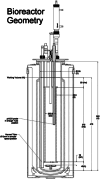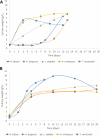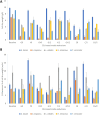Airlift bioreactor-based strategies for prolonged semi-continuous cultivation of edible Agaricomycetes
- PMID: 38888638
- PMCID: PMC11189342
- DOI: 10.1007/s00253-024-13220-4
Airlift bioreactor-based strategies for prolonged semi-continuous cultivation of edible Agaricomycetes
Abstract
Submerged cultivation of edible filamentous fungi (Agaricomycetes) in bioreactors enables maximum mass transfer of nutrients and has the potential to increase the volumetric productivity of fungal biomass compared to solid state cultivation. These aspects are paramount if one wants to increase the range of bioactives (e.g. glucans) in convenient time frames. In this study, Trametes versicolor (M9911) outperformed four other Agaricomycetes tested strains (during batch cultivations in an airlift bioreactor). This strain was therefore further tested in semi-continuous cultivation. Continuous and semi-continuous cultivations (driven by the dilution rate, D) are the preferred bioprocess strategies for biomass production. We examined the semi-continuous cultivation of T. versicolor at dilution rates between 0.02 and 0.1 h-1. A maximum volumetric productivity of 0.87 g/L/h was obtained with a D of 0.1 h-1 but with a lower total biomass production (cell dry weight, CDW 8.7 g/L) than the one obtained at lower dilution rates (12.3 g/L at D of 0.04 and vs 13.4 g/L, at a D of 0.02 h-1). However, growth at a D of 0.1 h-1 resulted in a very short fermentation (18 h) which terminated due to washout (the specific D exceeded the maximum growth rate of the fungal biomass). At a D of 0.04 h-1, a CDW of 12.3 g/L was achieved without compromising the total residence time (184 h) of the fermentation. While the D of 0.04 h-1 and 0.07 h-1 achieved comparable volumetric productivities (0.5 g/L/h), the total duration of the fermentation at D of 0.07 h-1 was only 85 h. The highest glucan content of cells (27.8 as percentage of CDW) was obtained at a D of 0.07 h-1, while the lowest glucan content was observed in T. versicolor cells grown at a D of 0.02 h-1. KEY POINTS: • The highest reported volumetric productivity for fungal biomass was 0.87 g/L/h. • Semi-continuous fermentation at D of 0.02 h-1 resulted in 13.4 g/L of fungal biomass. • Semi-continuous fermentation at D of 0.07 h-1 resulted in fungal biomass with 28% of total glucans.
Keywords: Airlift fermentation; Bioactives; Filamentous fungi; Volumetric productivity.
© 2024. The Author(s).
Conflict of interest statement
The authors declare no competing interests.
Figures








References
-
- Adams EL, Rice PJ, Graves B, Ensley HE, Yu H, Brown GD, Gordon S, Monteiro MA, Papp-Szabo E, Lowman DW, Power TD, Wempe MF, Williams DL (2008) Differential high-affinity interaction of dectin-1 with natural or synthetic glucans is dependent upon primary structure and is influenced by polymer chain length and side-chain branching. J Pharmacol Exp Ther 235(1):115–123. 10.1124/jpet.107.133124 - PubMed
-
- Berovic M, Podgornik B (2016) Cultivation of medicinal fungi in bioreactors. Mushrooms Biotech 155–171. 10.1016/B978-0-12-802794-3.00009-6
-
- Boddy L, Crockatt ME, Aynsworth AM (2011) Ecology of Hericiumcirrhatum, H.coralloides and H.erinaceus in the UK. Fungal Ecol 4:163–173. 10.1016/j.funeco.2010.10.001
-
- Bozbulut R, Sanlier N (2019) Promising effects of β-glucans on glyceamic control in diabetes. Trends Food Sci 83:159–166. 10.1016/j.tifs.2018.11.018
-
- Cerrone F, Barghini P, Pesciaroli C, Fenice M (2011) Efficient removal of pollutants from olive washing wastewater in bubble-column bioreactor by Trametesversicolor. Chemosphere 84:254–259. 10.1016/j.chemosphere.2011.03.066 - PubMed
MeSH terms
Substances
Supplementary concepts
Grants and funding
LinkOut - more resources
Full Text Sources

